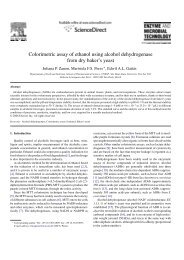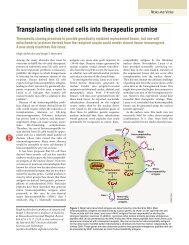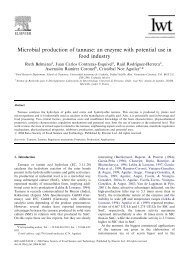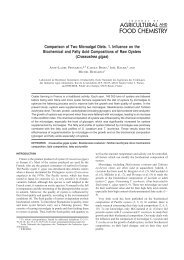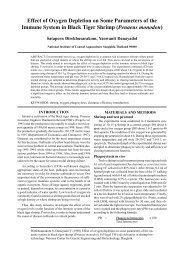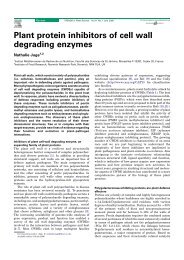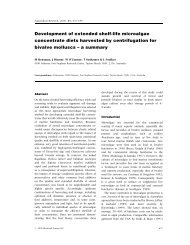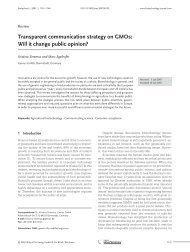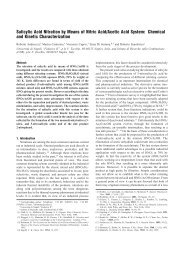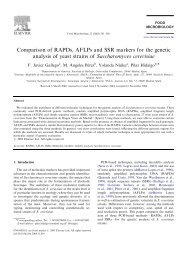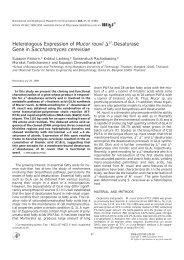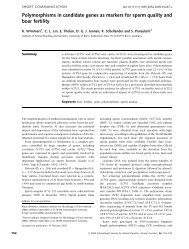Enzymatic microreactors in chemical analysis and kinetic studies
Enzymatic microreactors in chemical analysis and kinetic studies
Enzymatic microreactors in chemical analysis and kinetic studies
Create successful ePaper yourself
Turn your PDF publications into a flip-book with our unique Google optimized e-Paper software.
2.1.4. Model enzymatic systems<br />
A variety of immobilization techniques <strong>and</strong> microfluidic<br />
designs have been used to build enzymatic<br />
<strong>microreactors</strong> designed for use <strong>in</strong> <strong>analysis</strong> of <strong>chemical</strong><br />
species (Table 2). The most widely-used supports for<br />
immobilization of enzymes are beads of silicon or glass,<br />
although there are numerous particular solutions <strong>in</strong>clud<strong>in</strong>g<br />
immobilization on the <strong>in</strong>ner walls of microfluidic<br />
channels <strong>and</strong> fused silica capillaries. The most popular<br />
enzymes for test<strong>in</strong>g immobilization efficiency <strong>and</strong><br />
assay<strong>in</strong>g the microreaction process are glucose oxidase<br />
(Murakami et al., 1993; Laurell <strong>and</strong> Rosengren, 1994;<br />
Laurell et al., 1995; Drott et al., 1997; Folly et al., 1997;<br />
Drott et al., 1999; Kulys, 1999; Niwa et al., 1999;<br />
Bengtsson et al., 2000; L’Hostis et al., 2000; Strike et<br />
al., 2000; Bengtsson et al., 2002; Mao et al., 2002; Park<br />
<strong>and</strong> Clark, 2002; Wilhelm <strong>and</strong> Wittstock, 2002; Zhan et<br />
al., 2002; Park et al., 2003; Holden et al., 2004;<br />
Nomura et al., 2004; Xu <strong>and</strong> Fang, 2004), horseradish<br />
peroxidase (Mao et al., 2002; Park <strong>and</strong> Clark, 2002;<br />
Wilhelm <strong>and</strong> Wittstock, 2002; Zhan et al., 2002; Heule<br />
et al., 2003; Lv et al., 2003; Seong et al., 2003; Holden<br />
et al., 2004) <strong>and</strong> alkal<strong>in</strong>e phosphatase (Mao et al., 2002;<br />
Park et al., 2003; Gleason <strong>and</strong> Carbeck, 2004; Holden<br />
et al., 2004; Koh <strong>and</strong> Pishko, 2005). These enzymes are<br />
relatively cheap <strong>and</strong> easily accessible, <strong>and</strong> their <strong>chemical</strong><br />
nature <strong>and</strong> the reactions catalyzed by them are well<br />
understood. In work by L’Hostis et al. (2000) a microscale<br />
electrochemilum<strong>in</strong>escence (ECL) detector was<br />
used to monitor the products of conversion of glucose<br />
by glucose oxidase immobilized on glass beads with<br />
lum<strong>in</strong>ol as a chelator. It allowed the detection of glucose<br />
with<strong>in</strong> the biologically-relevant range 50–500 AM.<br />
In the near future, it is expected that work us<strong>in</strong>g model<br />
enzymes will be augmented by <strong>studies</strong> with other<br />
enzymes useful for analytical assays.<br />
2.2. Other applications<br />
Apart from applications <strong>in</strong> <strong>analysis</strong> of <strong>chemical</strong><br />
species, several of the methods presented <strong>in</strong> the previous<br />
sections are also useful <strong>in</strong> k<strong>in</strong>etic characterization<br />
of enzymes. This will be covered <strong>in</strong> Section 2.2.1.<br />
There have been several attempts to use imag<strong>in</strong>g techniques<br />
to directly visualize with<strong>in</strong> the microchannel the<br />
product formed <strong>in</strong> the course of reaction. Imag<strong>in</strong>g<br />
techniques applied with enzymatic <strong>microreactors</strong> are<br />
discussed <strong>in</strong> Section 2.2.2.<br />
2.2.1. K<strong>in</strong>etic <strong>studies</strong><br />
Microreactors offer significant advantages for onl<strong>in</strong>e<br />
monitor<strong>in</strong>g of biocatalysis <strong>and</strong> characterisation of<br />
k<strong>in</strong>etics of supported enzymes. Generally, such<br />
enzymes are of better stability than when <strong>in</strong> free solution<br />
(Cao, 2005). Microreactors enable the key parameters<br />
characteris<strong>in</strong>g the k<strong>in</strong>etics, Km <strong>and</strong> vmax, tobe<br />
determ<strong>in</strong>ed for immobilized enzymes. Characterization<br />
of new immobilized enzymes can be facilitated by<br />
us<strong>in</strong>g m<strong>in</strong>iaturized systems <strong>in</strong> cont<strong>in</strong>uous flow mode.<br />
Results are obta<strong>in</strong>ed us<strong>in</strong>g very small quantities of<br />
immobilized enzymes <strong>and</strong> the methods are readily amenable<br />
to automation of the protocols. Such methods<br />
overcome problems with batch assays for immobilized<br />
enzymes, e.g. the difficulty of mix<strong>in</strong>g of the solid<br />
particles conta<strong>in</strong><strong>in</strong>g supported enzyme with the substrate<br />
solution.<br />
Seong et al. (2003) showed that the Michaelis constant<br />
determ<strong>in</strong>ed with a microfluidic device with immobilized<br />
horseradish peroxidase was similar to the value<br />
obta<strong>in</strong>ed dur<strong>in</strong>g homogeneous catalysis <strong>in</strong> batch mode.<br />
An <strong>in</strong>terest<strong>in</strong>g method for determ<strong>in</strong><strong>in</strong>g K m <strong>and</strong> v max<br />
was presented by Jiang et al. (2000a), who applied onl<strong>in</strong>e<br />
frontal <strong>analysis</strong> of peptides orig<strong>in</strong>at<strong>in</strong>g from the<br />
digestion by tryps<strong>in</strong> immobilized on glycidyl methacrylate-modified<br />
cellulose. The L<strong>in</strong>eweaver–Burke diagrams<br />
were easily constructed, based on the effects of<br />
<strong>in</strong>jection of different concentrations <strong>and</strong> variation of<br />
flow rate of the substrate solution. Bilitewski et al.<br />
(2003) highlighted the application of microfluidic systems<br />
to enzymatic reactions.<br />
In many cases, an enzymatic reaction is very fast <strong>and</strong><br />
can reach equilibrium with<strong>in</strong> a s<strong>in</strong>gle passage of substrate<br />
stream through the microreaction channel. However,<br />
several biotransformations, for example those<br />
catalyzed by lipases, are slower. In these cases, a recirculat<strong>in</strong>g<br />
system can be constructed us<strong>in</strong>g a loop of<br />
tub<strong>in</strong>g together with the reactor, as <strong>in</strong> Fig. 3 (Pijanowska<br />
et al., 2001). The substrate solution was<br />
pumped through the system with a peristaltic pump.<br />
Three types of immobilization were tested, <strong>and</strong> high<br />
performance of the units was demonstrated with either<br />
glass beads or nitrocellulose sheets as enzyme carrier,<br />
while entrapment with<strong>in</strong> alg<strong>in</strong>ate gel beads was shown<br />
to give unsatisfactory results. Hydrolysis of the substrate<br />
was measured by change of pH dur<strong>in</strong>g the <strong>in</strong>itial<br />
phase of the reaction over a 25 m<strong>in</strong> period; the time to<br />
reach the steady-state was estimated at 110 m<strong>in</strong>. Use of<br />
pH measurement to monitor progress of the reaction<br />
was shown to be sensitive, 0.478 pH/mM for tributyr<strong>in</strong><br />
(b4 mM). Scal<strong>in</strong>g down the dimensions of the microreactor,<br />
<strong>and</strong> immobiliz<strong>in</strong>g the enzyme (lipase) <strong>in</strong>side a<br />
fused silica capillary leads to very short times for the<br />
hydrolysis (Kaneno et al., 2004). This shows that application<br />
of <strong>microreactors</strong> with immobilized lipases




